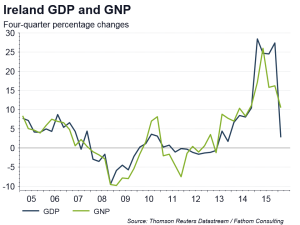A sideways look at economics
While many of us in the UK have been struggling to understand the consequences of last month’s Brexit vote, our neighbours across the Irish Sea have seized the opportunity to release a rather staggering set of economic data. Ireland’s Central Statistical Office this week revised up its estimate of growth last year from an already impressive 7.8%, to a literally incredible 26.3%. Talk about rubbing salt into the wound!
Readers will not be surprised to learn that last year’s growth spurt smashed Ireland’s previous record, set in 1995, when the economy expanded at a more leisurely 12.0% pace. Sadly, Ireland cannot claim the prize for the fastest rate of growth ever enjoyed by any country, anywhere in the world. That record is still held by Oman, which expanded by an eye-watering 189.8% in 1965, one year after oil was discovered in the Sultanate.
Analysis of Ireland’s economy is, of course, complicated by its rather generous approach to corporate taxation. Changes in the number of large multi-nationals that choose to base themselves in the Emerald Isle mean that many of the official statistics, although technically correct, are of almost no practical use.
On a more serious note, if we look at alternative indicators of economic activity, such as growth in household incomes, it is undeniable that Ireland has had a good run. Nevertheless, in light of its substantial exposure to the UK, which in 2014 purchased exports equivalent to almost a fifth of Ireland’s Gross Domestic Product, all of that may be about to change.
